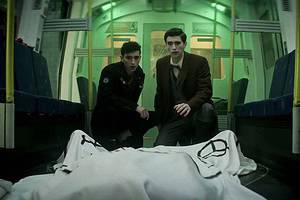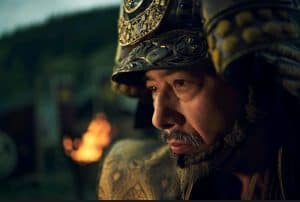It isn’t uncommon for a film to feature the same actor portraying a character across different time periods. However, it’s less common for one actor to portray two different characters across time, let alone people from the same family tree. This is the challenge Amrit Kaur (The Sex Lives of College Girls) took to tell director Fawzia Mirza’s deeply personal story in SXSW Film & TV Festival selection The Queen of My Dreams. Hot off of a lauded premiere at the Toronto International Film Festival last year, Mirza’s film sees Kaur in two key roles: as Azra, a young drama student studying in Toronto circa 1999, and Mariam, a free-spirited teenager growing up in Pakistan circa 1969. The catch is that Mariam is Azra’s mother, portrayed in 1999 by renowned actress Nimra Bucha (Ms. Marvel, Polite Society).
The choice to double-cast Kaur is an homage to Bollywood, specifically the 1969 film Aradhana, where male lead Rajesh Khanna plays both a father and his son. Shakti Samanta’s blockbuster romance is referenced several times throughout the film, including an early scene where Azra and her girlfriend, Sharon (Charlie Boyle), watch the film and have different reactions. Sharon is confused at the double-casting, while Azra, who has adored the film since childhood, is so swept up in the emotion that she can overlook any potentially dated details. It may at first confuse audiences to see Kaur in both roles––though the actress’ remarkable dual-performance gives both women their own unique presence––but patient viewers will quickly see that this decision connects the film’s characters in a gorgeously tender web that dissects and bridges generational division with heart and hope.
Mirza’s entire film is immersed in thoughtful nostalgia, at first for Bollywood but later for both Azra and Mariam’s ephemeral youth. Later on in Queen’s runtime, Mirza fuses a third timeline into the mix, one with a young Azra (Ayana Maji) as a burgeoning queer woman, and all three of these timelines feature a number of stylistic flourishes: vibrant colors, lucious costumes, whip pans, film grain, and more. When combined, it creates for a cinematic experience that pops off the screen without ever feeling kitschy or gimmicky. The Queen of My Dreams evokes old media with a story firmly planted in the present, further cementing Mirza’s film as an introspective story at its core. It puts several generations in conversation in the hopes that, even when looking toward the past, families can move forward.
Mirza and Kaur spoke to GVN about all of this, and more, while in Austin for the film’s U.S. Premiere at SXSW. Here is our conversation, edited for length and clarity.

We need to start by talking about the choice to have Amrit portray both Azra and a younger Mariam. Was this a conscious choice from the beginning?
Fawzia Mirza: It wasn’t a conscious choice from the beginning but, before we went into casting, I decided that that had to be the way it was done. I had a lot of conversations about how we were going to cast so that the different time periods felt consistent. There are some films that are great examples of casting for different time periods, whether it’s The Hours or Moonlight. I went back to the inspiration for the film, Aradhana, the 60s [Bollywood] film, and was reminded of the mothers [who were also double-cast]. Doubling is a great device often used in Bollywood films. It’s the literalization of the theme and its emotionality. Once I landed on it, I was like “Oh my God, why haven’t I been thinking about this the whole entire time.” I knew it would be hard because to do that, to carry the film, you need a great actor.
There’s a scene toward the end of the film in which Gul-e-Rana, who plays Azra’s grandmother, interacts with her. Before this, the only time we saw her on-screen interacting with Amrit was when she was performing as Mariam. Fawzia, this literalization of the theme you are referring to, I felt that especially in that scene. What was the feeling for you filming that on set?
Mirza: It’s so hard to know. In the moment, you’re often thinking about all the practical things of making that moment happen, but I knew that this scene was important. There’s so much fantasy in the film and one of them is that we can find forgiveness across generations. That was something I wanted to fantasize about for all of us and one of the offerings of hope I wanted to give [audiences].I’m so glad that it resonated.
Amrit, how did you feel about taking on two roles and what was your process?
Amrit Kaur: I loved that I got to [perform] two roles. It was fantastic. There’s so much process. I did an embodiment exercise for Azra. There was already a person whose walk, body, voice I felt worked very in-line with her character, so I would work on morphing my body in that way, walking in my hips that way. Then, alternatively, for Mariam, I did something called animal work, where you find an animal that you think their spirit and energy mimics. That was the Marwari horse, for me. It’s a majestic horse, it’s very regal, and that was Mariam. More high class, royal. She has a forward-going trot to her about life. Nimra’s personality is very vivacious. She’s very big. I was like, “Okay, I need to be extroverted.” There were days––almost every day––switching between both characters where I would be like, “I need 10 minutes to do my embodiment work or my animal work.” That is the major thing I did to differentiate the two.

Amrit, let’s talk about working with Nimra Bucha. Some people who work on films like this like to speak to the actors playing the same character. There are some people who are like, “I don’t want to talk to them at all because I’m playing this version of them, they’re playing their version of them.” What was your approach to your relationship with Nimra?
Kaur: We didn’t talk too much about it. There was a moment where [we spoke about] our accent. Does the accent change because she’s been in Canada for a long time and has she travelled, etc. That was the main discussion but other than that, we were very independent.
Talk to me about working with Fawzia. Was there a specifically memorable trait or moment you experienced on set that you think encapsulates your experience working with her?
Kaur: Two moments, actually. First, I remember her commanding the set with the energy of a woman not trying to prove that she belongs on set but that she just is there. That’s not common to come by in women. Second, [I remember shooting] the scene when I first see my mother after I come off the plane and I’m crying. I kept coming out and being like, “Am I telling your story?” Because it’s personal to Fawzia and her father passing. “Do you feel seen?” She cried and she was like, “Yes, I feel seen. You’re doing great.” That moment was so important to me.
Fawzia, you direct with such style. I love the whip panning, for example. I find it’s a technique normally used for tone, but here it feels like it’s a device that’s moving the story forward, in a way. Where did the decision come from to incorporate those?
Mirza: I love the whip pan as a device but I also think that it has a connection to old media. When I first wrote the film, I didn’t have the thought, but as I was really sinking into the story, I realized that it’s a memory film. It’s a film about memory and the past, present, and the future. As we are seeing the nostalgia that we have for old techniques and old media, for corded phones, all of that stuff––that technology we crave is of a simpler time. Maybe it’s better than where we’re heading. There was something about wanting to create a memory, not just the whip pan but giving the feeling of a projector slide and the sound of a slide. I grew up in a family where, on Friday nights, people would come over for dinner and my dad would show slides of his trips in the basement. There was something in that that I wanted to evoke for the audience.
I think you can also feel that in the Bollywood sequences. Keeping in line with this analog conversation, were there any techniques that you used to make those sequences feel a bit more distinct?
Mirza: The film essentially has five looks. You have the three time periods but then you have the fantasy sequences and you have the original footage of Aradhana, so the film within the film. I wanted vibrance in all of them. My DP [Matt Irwin] created a LUT for the entire film so that we could see at least a version of that vibrancy, and then in post we tweaked it. We did want it to feel all a little different, even the different time periods. But [regarding] the older media, you do have a little bit of grain that’s applied. With the fantasies in particular, Aradhana is from the 1960s and those old films use the quick zooms that we used to use that we’re seeing ironically again a lot. We didn’t do that to be on trend, we did that to capture the past and to capture the memory of the moment and the nostalgia and the comedy of the past. We definitely had a lot of fun with style through the film.

Amrit, the costumes are so incredible in this film. Was there a joy in being absorbed by all of this vibrancy and color through your wardrobe?
Kaur: It’s part of being in the culture, it’s colorful. The color is the culture. For Mariam, doing the hair and makeup took three hours to look like that. I don’t look like that. She has a lot more hair and much better skin than me. It was fun to play a character that had such prep. When [co-star Hamza Haq] in the car and we’re smoking and about to kiss, [my] big hair, I love that. They had mood boards of all the famous looks from that time and different actresses that she would model her looks based off of. That was incredible.
In the film, Mariam has this almost infatuation with Bollywood and it’s passed down to her daughter, Azra, who, even in her growing adulthood, looks back on it as some sort of rush. Bollywood’s not exclusive to this nostalgic idea, but I do think that the genre has a unique appeal for young people that a lot of other genres in American cinema do not have. I was curious if you went into this film conscious of that and how it would affect the coming-of-age elements of the story.
Mirza: Oh my god, I have to tell you that I didn’t. Anything I do and any conversation I have or any work that I make, it’s always inspired by my POV, regardless of who the characters are or the world is. My POV is definitely shaped and inspired by growing up watching three-hour Bollywood films that are comedies, dramas, fantasy, horror sometimes, multi-genre musical films. Anything can happen, anything is possible. There is such big, expansive romance and possibility and grand gestures. I’m a Pisces. That really spoke to me and has stuck with me. I feel like the youngest people are dreaming in an expansive way much more than the last few generations have. That’s so cool. There’s so much to take from that and glean from that and learn from that because we need that kind of fantasy to have hope for the future.
My last question is for you, Amrit. This film originally premiered in Toronto and people loved it there. SXSW is a different crowd but one that also loved it. Is there something that you’re excited for in getting to bring this film to the United States?
Kaur: My mission has always been to elevate Canadian talent. I think that’s really important. An actress I think of is Olivia Colman, who’s worked years and years and done a lot of her work in England and grown with England and [worked on] growing the industry. I want to do that. I want to be part of elevating Canada and supporting Canadian talent. That’s what I’m excited about. There’s so much! Sarah Polley, Jim Carrey, Ryan Gosling, Ryan Reynolds. We have phenomenal talent, but we go to America because there’s more permission there, permission to be brave, to be ugly, for whatever reason. Let’s bring that permission to Canada. We’re too polite. We’re scared of our own ugliness, but it’s what we relate to, so I think there’s starting to be a change in that. To keep it going, that’s going to take a while.
The Queen of My Dreams held its U.S. premiere as part of the Festival Favorites section at this year’s SXSW Film & TV Festival. It is currently seeking U.S. distribution.

Larry Fried is a filmmaker, writer, and podcaster based in New Jersey. He is the host and creator of the podcast “My Favorite Movie is…,” a podcast dedicated to helping filmmakers make somebody’s next favorite movie. He is also the Visual Content Manager for Special Olympics New Jersey, an organization dedicated to competition and training opportunities for athletes with intellectual disabilities across the Garden State.







